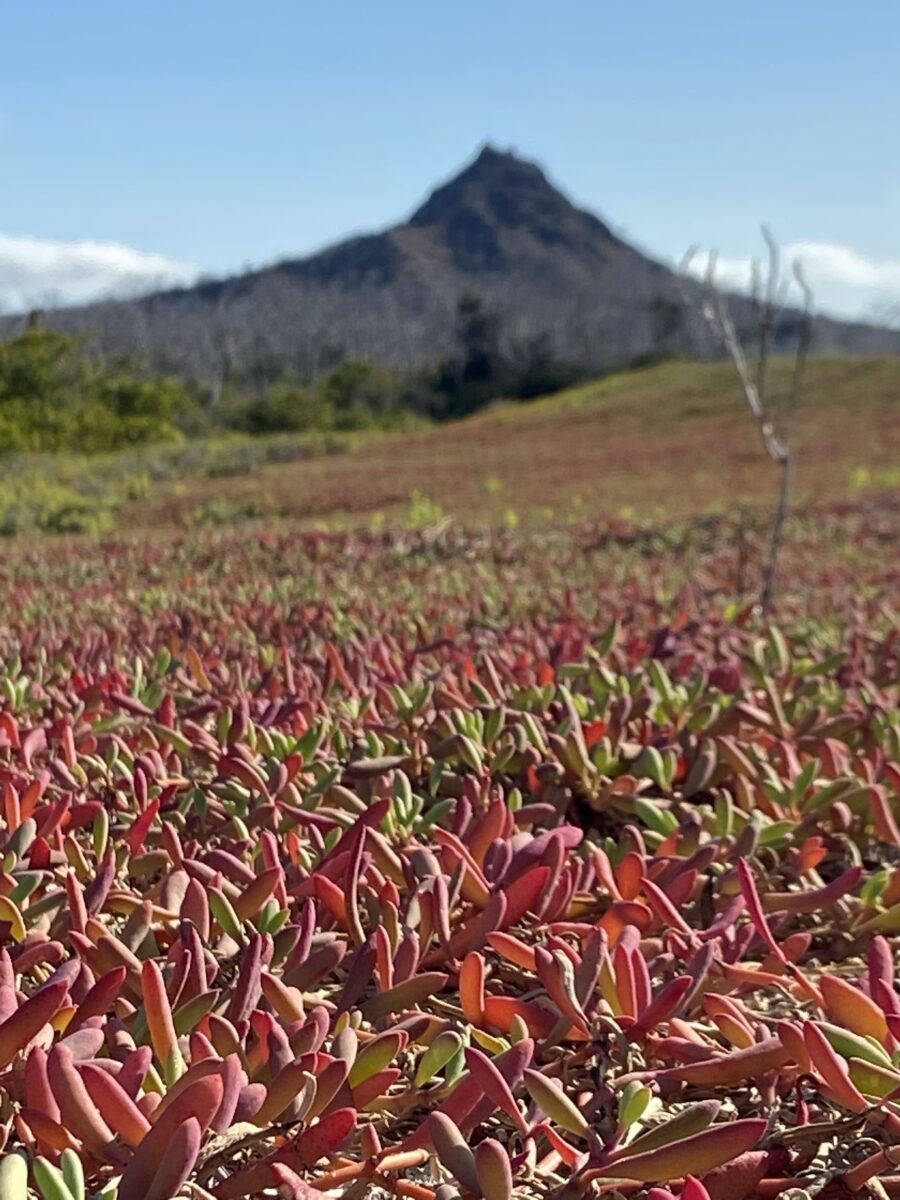Galápagos: the end and the beginning of the world
The Galápagos are the end and the beginning of the world: down there, everything is order and beauty. In front of Kicker Rock (or the Sleeping Lion), in this first image, I am sitting at the bow, the water is cut off by the tip of the Yate Darwin (this is the name of our boat). My travelling companions and I have dubbed this area ‘the secret place’ even though it is not at all unfamiliar: we all know it, it is simply a part of the boat where in small groups we come to sit and enjoy the view and the company and silence of the others who sail this ocean. We stop while waiting for our dinner and a seal with a huge fish in its mouth appears in the waves.
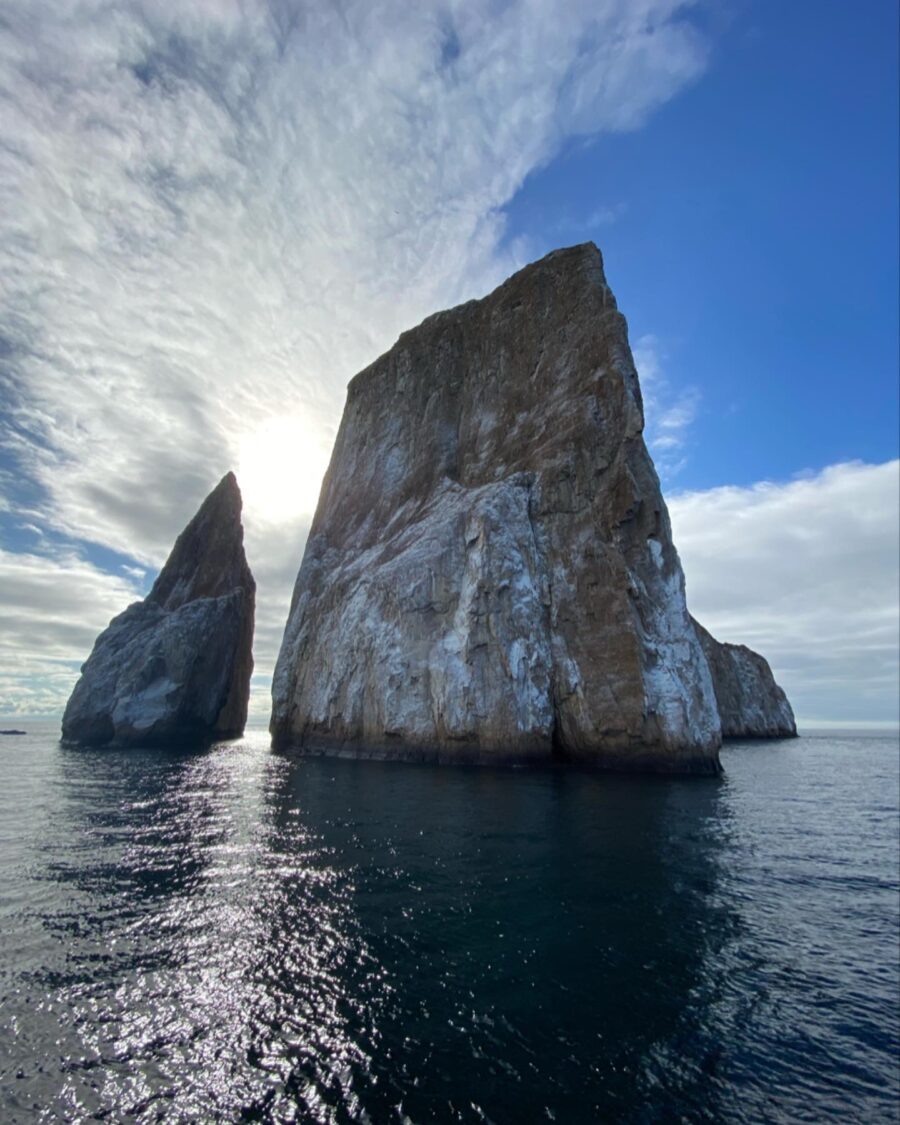
All around us are uninhabited islets (it is estimated that the Galápagos is 97% empty of humanity), small atolls, some have been christened, while most have no name. They are in a paradise almost completely untouched by humans: here the animals are not frightened because they are the rightful residents of these places. Sunset comes, and even though we are far from other islands, the roar of the waves crashing there reaches our secret place. Every now and then some bird jumps into the sea and fishes. Everything seems distant and ancestral.
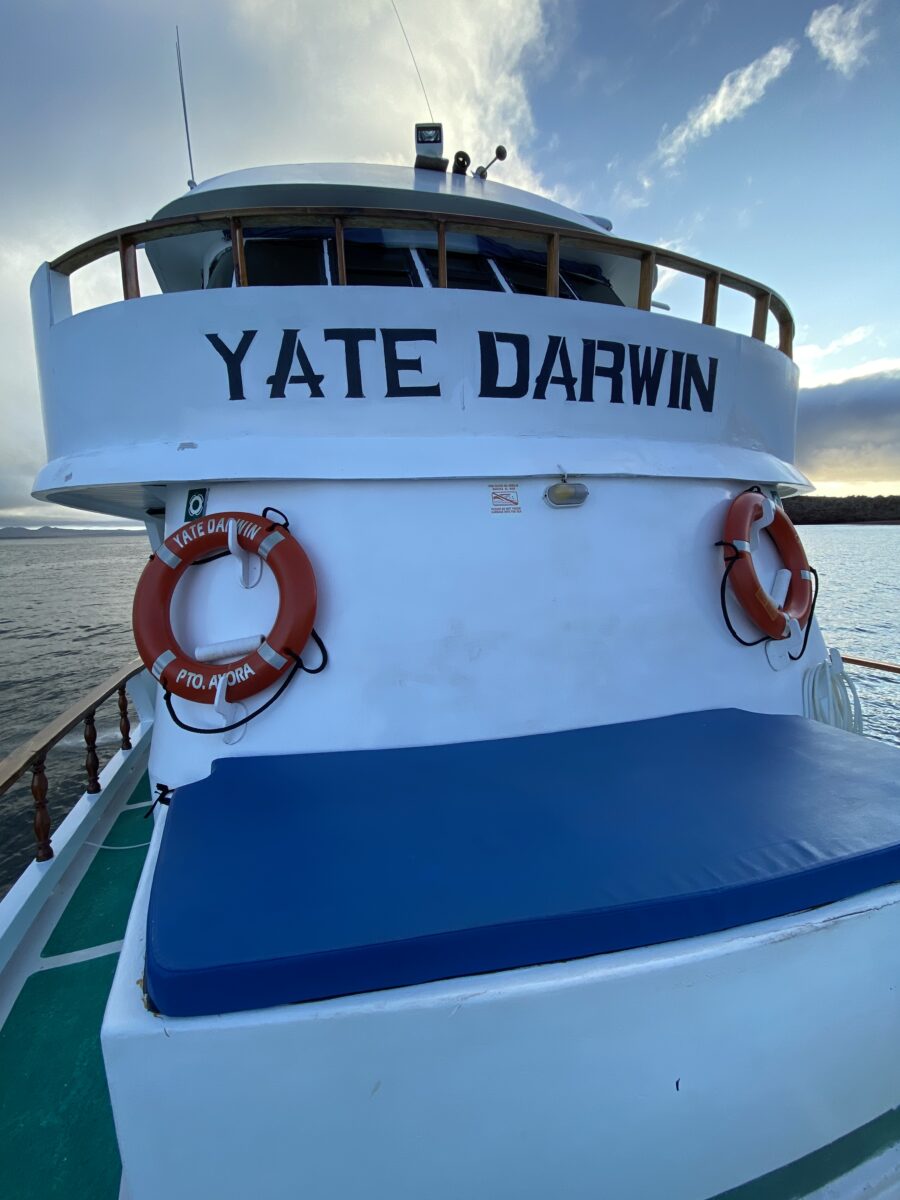
The abundance of Pachamama
The Galápagos is the representation of abundance on this planet. A trip to this archipelago conveys the idea of the richness of this part of the world, not only because of the incredible amount of animals you will see if you get there, but also because of the biodiversity of the vegetation and geology of these islands.
Isla Rábida appears to me from the bow of the Yate Darwin in the morning and already from here it looks like a vision. It is a relatively small, arid island with steep slopes. Most of the coast is rocky, except for a very long beach of red sand (due to the high concentration of iron in the lava that formed this island) on the northeast side. We stop right here for a few hours and jump into the water: sea lions – especially the little ones – play in the waves, and some – the bravest and most mischievous – play with the braces of our swimming suits.

In the Dragon Hill area, on Isla Santa Cruz, the magnificence of the plant world explodes. To this day, I still remember this stop as one of the most exciting of the entire trip because here are entire forests of palo santo, the incense tree, and decades-old cacti, metres and metres high, accommodating on their tops small yellow flowers, the favourite snack of Darwin’s finches. In the distance, a huge volcanic crater and a much more imposing vessel than our little Yate Darwin can be seen. Just before we get back on board, I find what looks like a sun-stained damask fabric on the ground: it is actually the internal structure of a cactus that helps the plant collect and distribute water to every part of the plant. In the Galápagos, nature is immense and invincible. No camera will ever be able to convey the opulence of this land.

On several islands, then, one encounters mangroves: these plants help conserve fresh water by filtering out salt water, because they have adapted throughout history to absorb oxygen and remove salt, which allows them to tolerate conditions that would kill most plants. But not only that: they can store significant amounts of carbon dioxide from the atmosphere, which makes them almost super heroes in the fight against climate change. They also prevent erosion by stabilising sediments with their roots, smooth ocean waves and prevent flooding during storms. Last but not least, they play a vital role in the nutrient cycle, contributing to the food web and supporting various marine organisms.
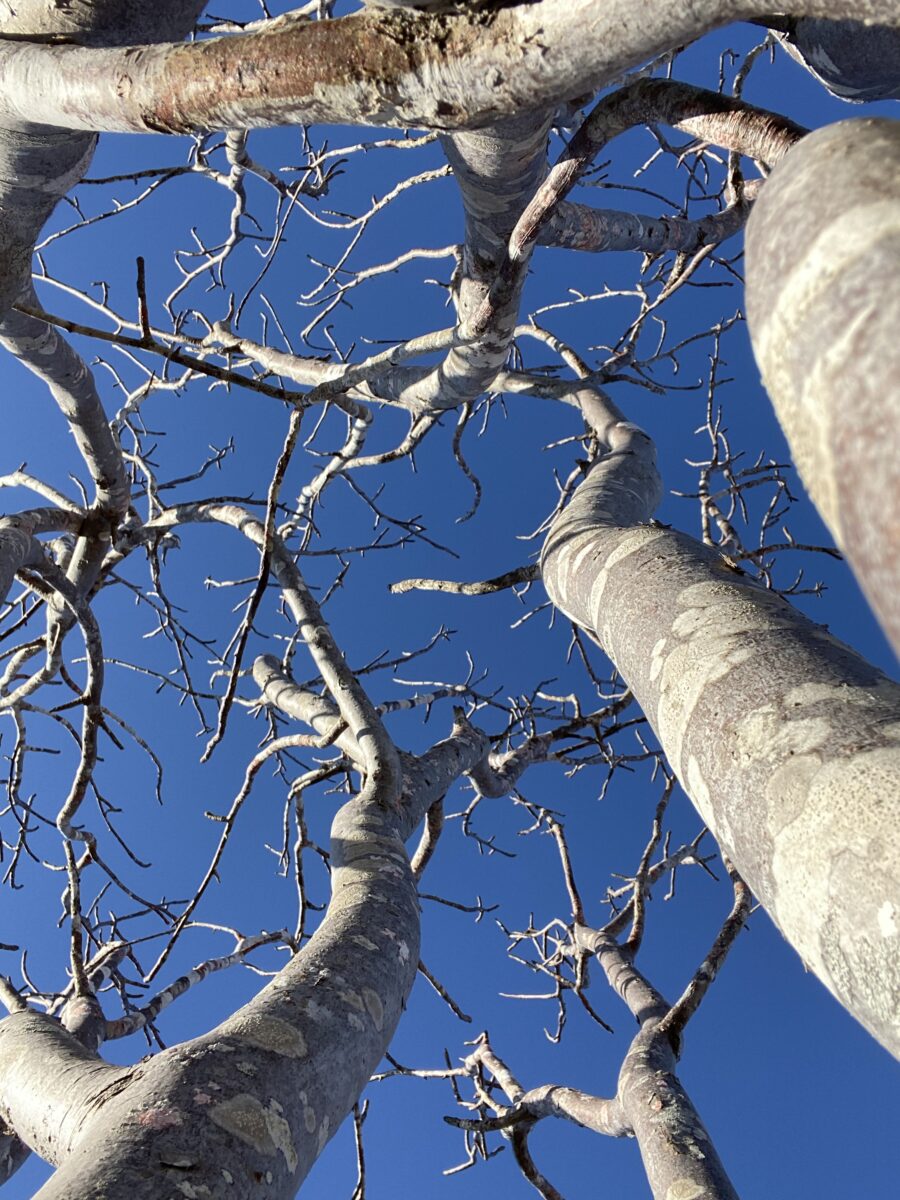
Kleptoparasitism
It is dawn, and after an apparently very eventful night during which I slept without dreams or anxiety, I get out of bed trying not to kill myself and go to the second floor of the Yate Darwin. Everyone is asleep, but the frigates are not resting. They feed on many different kinds of fish, but they cannot land on water because their feathers are not waterproof. If they did, they would no longer be able to take off. So they fly above our boat, often accompanying us on our crossings, cutting through the wind.
They are also fascinating birds on an aesthetic level, because apart from having a scissor-like tail, both males and females are all black except for their breasts: the females have a white spot there that can extend up to the neck, while the male has a huge red throat pouch. During the breeding season, the male pushes the air there and inflates it, even for a period of about 20 minutes: they put on airs, and in doing so make the ladies fall in love!
They never seem to get tired, there in the wind, but perhaps they find their strength from the group: they are always in a group as they follow us across the Pacific. There is a very specific reason why this happens, though: flocks of frigates often work together to steal food from other bird species; they pull at the tails and feathers of their ‘opponents’ until the latter spit out their meal to escape. Frigates are therefore called kleptoparasites: they steal as much as they can from as many birds as they can!
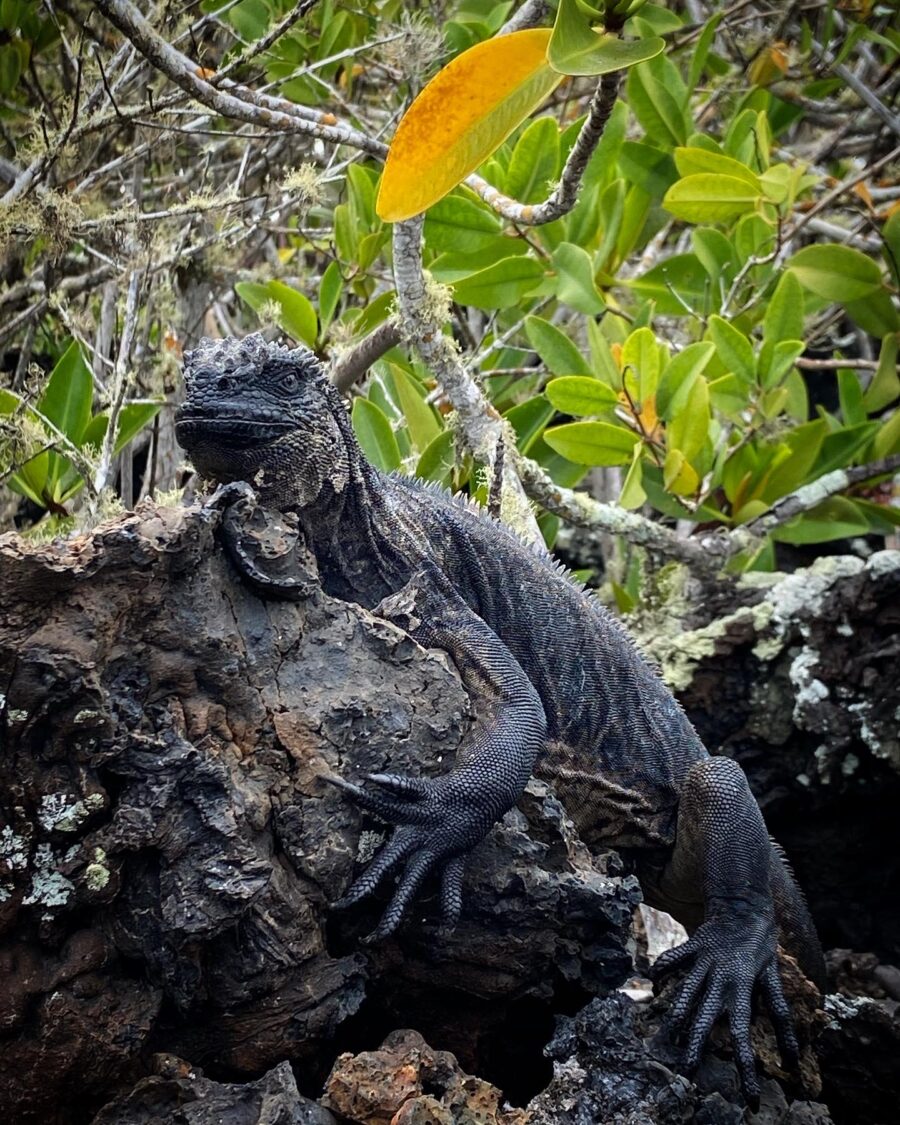
Ode to iguanas
As I told you in the first article, iguanas were the first animals to welcome me to the Galápagos, but I encounter them again and again during the various stops on my cruise. Many say they are ugly. I care to disagree for several reasons: firstly, marine iguanas have been through time, and have differentiated themselves through the different geological eras from their terrestrial cousins. Galápagos marine iguanas are famous for being the only marine lizards in the world. Furthermore, their underwater feeding habits are another remarkable feature, as they feed extensively on the algae that grow on top of submerged rocks. They are therefore mainly vegetarian. Furthermore, unlike the feathered creatures that soar in the Galápagos, marine iguanas cannot simply fly away from their harsh environment if they face difficult times (in terms of nourishment and food). For Galápagos marine iguanas, it is a matter of adapt or die. As a result, these incredible reptiles are able to shrink their bodies to be less dependent on large amounts of food. It is a fascinating feature that allows them to improve their chances of survival and pass on their genes to the next generation.
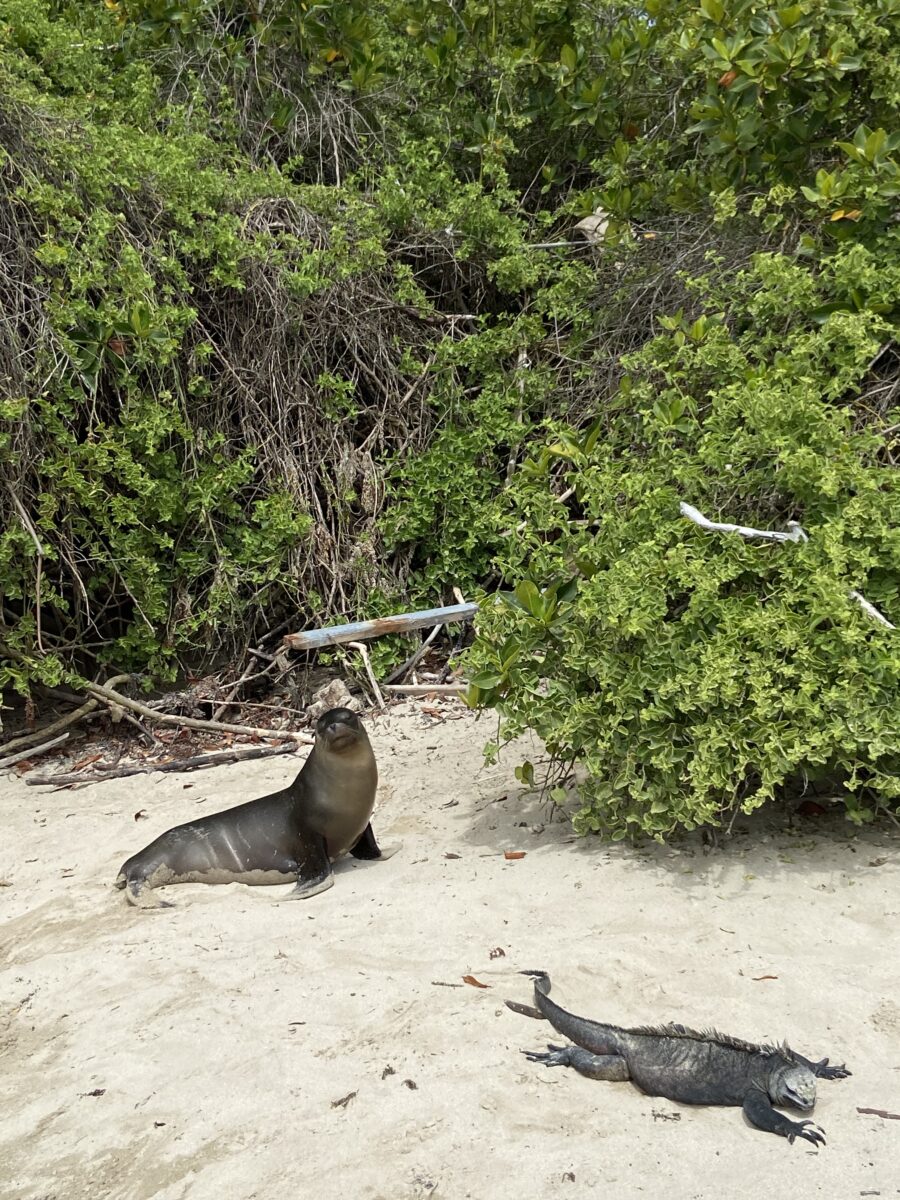
But it doesn’t end there. As I mentioned above, these reptiles are big fans of algae (as well as crabs and … sea lion droppings!). On dives that take them in search of their favourite food, they often descend many metres below sea level and can hold their breath for up to an hour. To do this, they are able to lower their heartbeats from 43 to 9 per minute. Back on dry land after such a sporting exploit, however, they need to recover: they lie motionless waiting to see if their heart has burst or not. This is how I find them on the beach of Isla Isabela: they lie in the sun next to gigantic sea lions. Both animal species completely ignore us as we watch and photograph them from a fair distance. We are totally insignificant to them – and to the iguanas, we are probably even sportingly ridiculous.
The land iguanas are no different. On Isla Cristobal, for example, they are so chameleon-like that at first I think I am hallucinating because it seems to me that the black rocks on the island are moving in slow-motion. In order to withstand the heat, which on these volcanic rocks can even reach 50C in the dry season, these reptiles put themselves in a position similar to sphinxes: they lift their chests off the ground to find some coolness from the boiling temperatures. In the area of Dragon Hill, on Isla Santa Cruz, I meet some huge ones, between one and two metres long: they munch on cacti here because they have adapted to the few food sources available in the Galápagos. They are colourful, from brownish to ochre to yellow to burnt orange. They are not aggressive. They have a few teeth located on the inside of their jaws. And they often scoop out the salt that is transported here in the air and by the waves, pulling it on themselves: that is why they sometimes have white crests (OK, the other reason they have white crests is because of the excrement that the blue-footed boobies give off, but that is another story!).
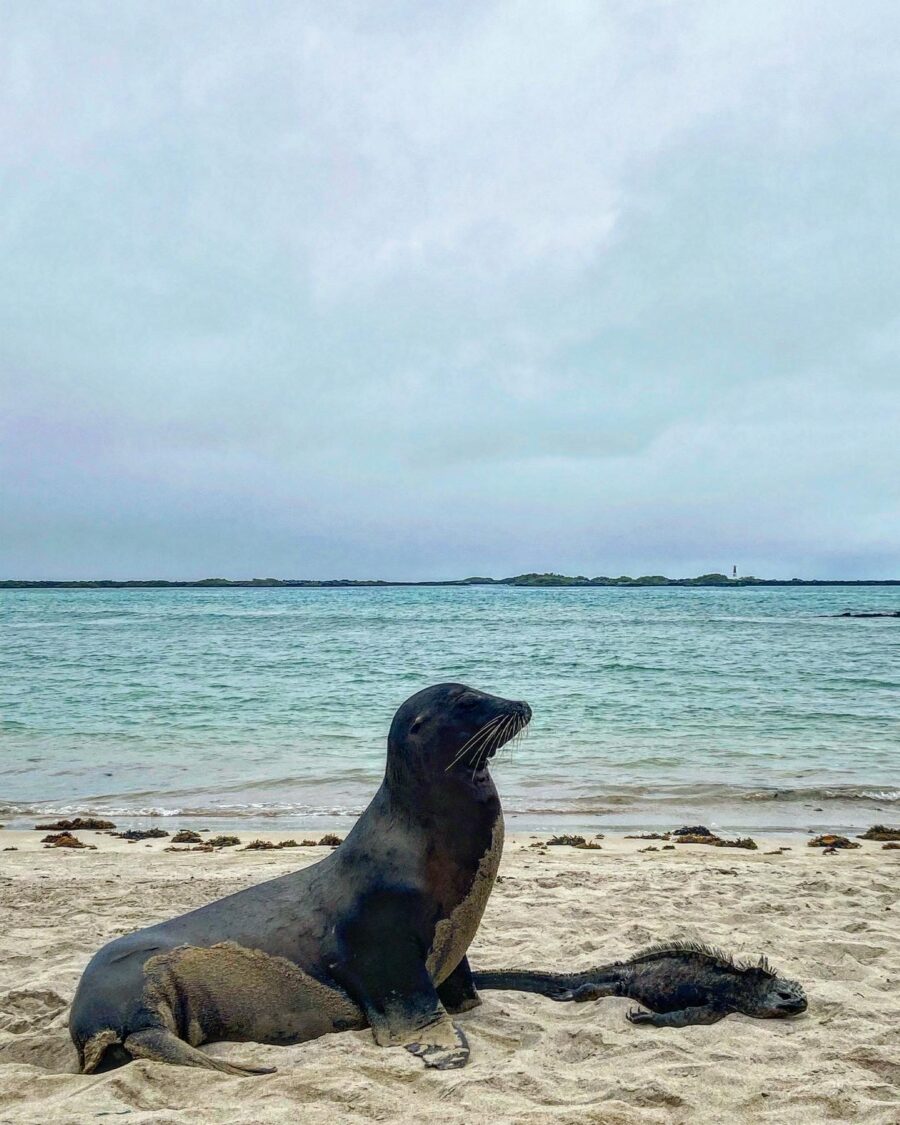
Sea lions are pranksters
Isla San Cristobal was formed more than 10,000 years ago, during the last ice age. The volcanic rocks crunching under my shoes are surely proof of this. However, this territory is also home to large colonies of sea lions: as is the case almost everywhere in the Galápagos, these animals are not disturbed by the presence of humans (you will also find them on Santa Cruz Island, amidst the little traffic) and so they continue to act as if nothing is wrong as they see us pass by (but not too much! Remember some tips I gave you in the first post dedicated to the Galápagos!).
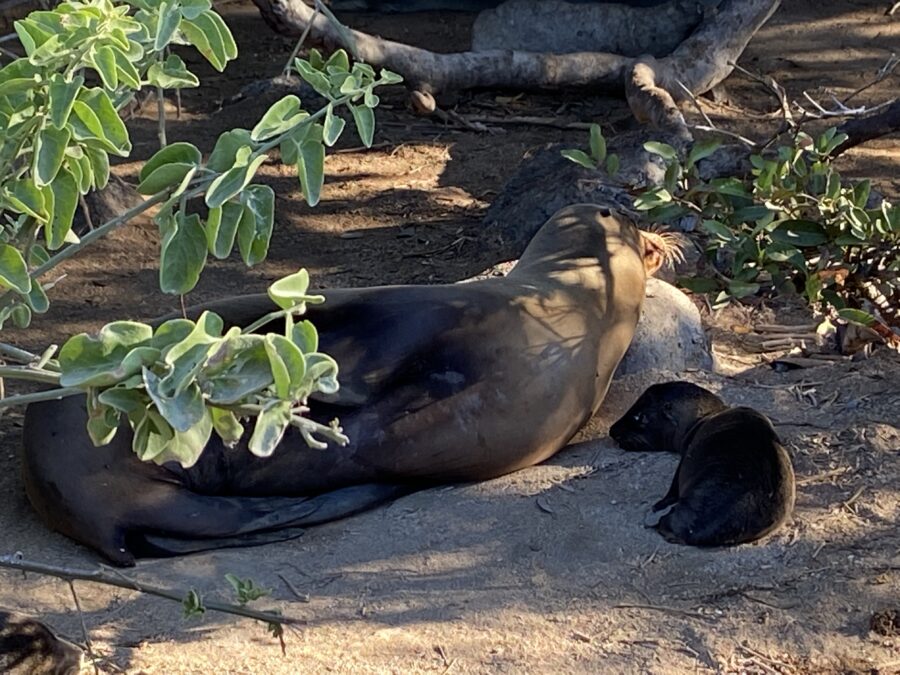
Many sit plump and peaceful lounging in the sun, and when flies or colourful crabs begin to bother them, they lazily move them with their little paws, almost bored. In the nurseries, that is, in those areas where pregnant females come to give birth and where the young spend their first periods of life, they get to participate fully in the grandeur of life. However, it must also be admitted that precisely in these special areas the air has no romantic fragrance!

Blue-footed boobies: silly to whom?
Blue-footed boobies look like clowns: they walk around swinging like clowns everywhere in the Galápagos, heedless of our presence. Probably, precisely because of their meekness and lack of fear of humans, they were easily killed by early mariners here who called them bobos (from the Spanish for “stupid”) to indicate their supposed lack of intelligence. Blue-footed boobies are instead unique birds.
In the case of blue-footed boobies, the characteristic from which the name is derived is interesting enough, but these birds are full of unique adaptations and behaviours. Having bright blue legs is an interesting decoration and apparently really drives the ladies crazy, but this trait is subject to sexual selection, which means that females prefer to mate with males that have brighter legs. Only the most colourful males pass on their genetics, producing chicks with the most colourful legs.
Moreover, blue feet are not just a decorative feature of these birds. The colour comes from carotenoid pigments in the fish they feed on. This is similar to the way flamingoes get their bright pink coloration. The blue colour is also a good indicator of the bird’s health: the brighter the legs, the better the immune system. In other words, then, pied blue-footed boobies are not born (nor do they die) with blue legs.
Blue-footed boobies, then, have nostrils on their beaks that are permanently closed. They therefore breathe through the corners of their mouths. This adaptation is because these seabirds dive for food, and closed nostrils better protect them from seawater. Who’s stupid now?
Over time, these birds have become very specialised in food selection: when their prey populations decline, on the one hand they can catch other species to avoid starvation, but on the other hand they cannot successfully raise chicks. This has happened precisely in the Galápagos, where sardine populations have declined. For this reason, overfishing is a serious problem for these wonderful animals.
[In the interest of fairness, I should inform you that there are also red-footed boobies: in addition to the defining feature of their name, these birds have a blue beak at the base that lightens as it tapers to a point. On my trip to the Galápagos, I saw far fewer of these exemplars, but don’t give up!].
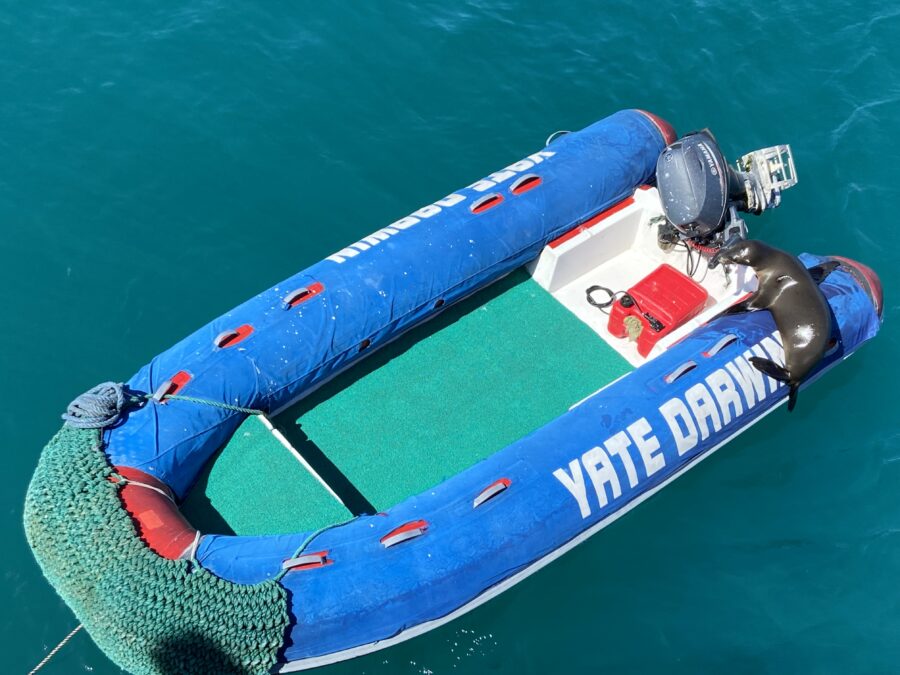
Adios, Galápagos!
Returning to Puerto Ayora after a week in the midst of all this causes a bittersweet feeling in me: I was fine on the Yate Darwin, far from the hubbub of the cities, but never so close to the planet. These days off the Pacific, it has become normal to watch the white sharks that come to touch our boat at night, not at all interested in us; we soon get used to seeing sunsets at the end of the world, the waves from which the occasional turtle’s head pops up or a sea eagle appears, a seal jumping onto our dinghy to sunbathe, not at all frightened of our presence. Observing Isla Daphne from afar, without disembarking because it is an official bird-finding site, or marveling at the shape of the Sombrero Chino, seem like regular, natural actions.

In Puerto Ayora, on the other hand, where about 15,000 people live, everything seems obvious to me. There are plenty of pharmacies, selling everything from medicines to wine to Ferrero Roche, and just as many agencies that organise daily or multi-day tours, and bars and restaurants, and mainly tourist stores. Puerto Ayora left nothing in me except two new encounters with the giant tortoises of the Galápagos. Seeing such an important animal again at the Charles Darwin Foundation, however, is immediately a different experience from the one we had a few days earlier at Black Turtle Cove on the north coast of Santa Cruz Island, accessible only by sea, where turtles swim and stick their heads out above the surface of the calm waters, while fish, stingrays, and small sharks swirl below us.
The feeling of melancholy grows a little more when I arrive at El Chato Ranch Dos which describes itself as “a private, family-owned ecological reserve that offers refuge” to these animals that give their name to the entire archipelago (galapago, in Spanish, actually means tortoise). From this estate located about 45 minutes from Puerto Ayora, the tortoises migrate to go lay their eggs, sometimes traveling as far as 30-40 kilometres. At the Ranch, however, they eat and breed. The sight of cows lying next to these chelonids in the meadows surrounding the ranch still comes back to me today as a surreal image.

The last memory I have, however, of the Galapagos is an image of care towards these turtles. And that is how I want to close this long post: on the road back from El Chato Ranch Dos, in the middle of the road, there is a tortoise. The slowness with which it moves makes it seem motionless from a distance. Two jeeps in front of ours stop about ten meters from the animal: four of them get out, lift it very gently, and carry it to the side of the road. She is safe.
